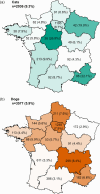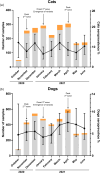A Large-Scale Serological Survey in Pets From October 2020 Through June 2021 in France Shows Significantly Higher Exposure to SARS-CoV-2 in Cats Compared to Dogs
- PMID: 39648678
- PMCID: PMC11772911
- DOI: 10.1111/zph.13198
A Large-Scale Serological Survey in Pets From October 2020 Through June 2021 in France Shows Significantly Higher Exposure to SARS-CoV-2 in Cats Compared to Dogs
Abstract
Introduction: Severe acute respiratory syndrome coronavirus 2 (SARS-CoV-2) has the potential to infect various animals, including domestic pets like dogs and cats. Many studies have documented infection in companion animals by molecular and serological methods. However, only a few have compared seroprevalence in cats and dogs from the general population, and these studies were limited by small sample sizes and collections over short periods. Our aim was to obtain a more accurate evaluation of seroprevalence in companion animals in France and to determine whether cats and dogs differ in their exposure to SARS-CoV-2.
Methods: We conducted an extensive serological survey of SARS-CoV-2, collecting blood samples from 2036 cats and 3577 dogs during routine veterinary medical examinations across different regions of metropolitan France from October 2020 to June 2021. This period encompassed the peaks and onset of two waves, as well as the emergence of the first variants. A microsphere immunoassay targeting the receptor-binding domain and trimeric spike protein was used to detect anti-SARS-CoV-2 antibodies. A subset of 308 seropositive samples was tested for the presence of neutralising antibodies.
Results: We determined an overall seroprevalence of anti-SARS-CoV-2 antibodies of 7.1% (95% confidence interval [CI]: 6.4%-7.8%) among the sampled pets. Cats exhibited a significantly higher seroprevalence (9.3%; 95% CI: 8.1%-10.1%) compared to dogs (5.9%; 95% CI: 5.2%-6.8%). Among the subset of seropositive samples, 81 (26.3%; 95% CI: 21.5%-31.6%) displayed neutralizing antibodies. Furthermore, seroprevalence in both species was lower in older animals and was not associated with sex. Finally, unlike cats, seroprevalence in dogs was found to be correlated with the date of sampling.
Conclusions: The large sample size enhances the reliability and statistical robustness of our estimates regarding pet exposure to SARS-CoV-2. This study on SARS-CoV-2 reaffirms the crucial importance of adopting a One Health approach incorporating domestic animals when managing an epidemic caused by a zoonotic virus.
Keywords: SARS‐CoV‐2; microsphere immunoassay; neutralisation assay; one health; pets; serology.
© 2024 The Author(s). Zoonoses and Public Health published by Wiley‐VCH GmbH.
Conflict of interest statement
The authors declare no conflicts of interest.
Figures



References
-
- Adler, J. M. , Weber C., Wernike K., et al. 2022. “Prevalence of Anti‐Severe Acute Respiratory Syndrome Coronavirus 2 Antibodies in Cats in Germany and Other European Countries in the Early Phase of the Coronavirus Disease‐19 Pandemic. Zoonoses and Public Health .” 69: 439–450. 10.1111/zph.12932. - DOI - PMC - PubMed
-
- Barroso, R. , Vieira‐Pires A., Antunes A., and Fidalgo‐Carvalho I.. 2022. “Susceptibility of Pets to SARS‐CoV‐2 Infection: Lessons From a Seroepidemiologic Survey of Cats and Dogs in Portugal.” Microorganisms 10, no. 2: 345. https://www.mdpi.com/2076‐2607/10/2/345. - PMC - PubMed
Publication types
MeSH terms
Substances
LinkOut - more resources
Full Text Sources
Medical
Miscellaneous

